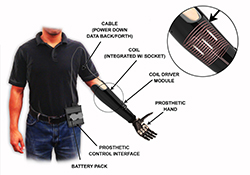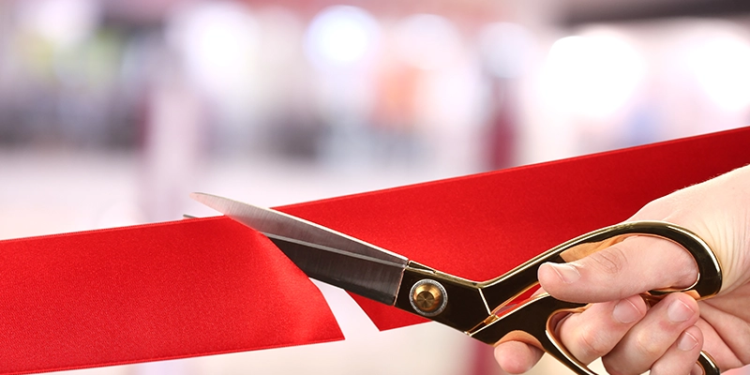
Illustration of the IMES System courtesy of The Alfred Mann Foundation.
When a muscles contracts, it generates electricity. This electrical activity remains in the muscles of an amputated limb. It has long been a goal to use these natural muscle signals to enhance the control of hand and arm prostheses. Previously, researchers did this by attaching two external sensors to the surface of the skin of the residual limb. The sensors were connected to a prosthesis controller by wires.
Detecting muscle signals on the surface of the skin limited the number of control sites available and only gave users the ability to open and close the prosthesis. Now, researchers are developing novel sensors that can be implanted directly into the muscles of the residual limb to create more control sites. These sensors wirelessly transmit intramuscular electrical signals from within the body to external electronics that command a prosthesis to move in a more natural way.
Richard Weir, PhD, and his team at the University of Colorado are refining this technology, with the goal of enabling individual finger control of a prosthetic hand. The key technology is known as an implantable myoelectric sensor (IMES) system, which enables an increased number of control sites to be used, providing enhanced, intuitive, simultaneous control of the many joints in the prosthetic hand. Because they are placed directly into the muscle, IMES sensors are more specific than the sensors currently placed on the skin.
The potential exists to implant each of the human forearm’s 18 muscles with a sensor that wirelessly transforms all those impulses into signals that can be used to control hand and individual finger movements. Current prostheses have only two sensors that send two signals: one to open and one to close the hand.
An important aspect of the work was determining the control potential and limitations of individual muscles. Using intramuscular electromyographic (EMG) electrodes, the group examined the ability of study participants to send signals from specific forearm muscles to specific fingers of the prosthetic hand.
Participants were able to activate multiple muscles to generate multiple signals simultaneously. This was a significant result because it demonstrated that forearm muscles retained the independent activity necessary for multiple prosthetic finger control. Additional research on the interactions between finger, thumb, and wrist muscles was critical for designing and controlling an artificial hand with similar capabilities to that of the human hand.
Staff Sergeant James Sides, who lost his forearm in Afghanistan, was implanted with eight myoelectric sensors that enable him to control the first prosthetic hand tested in a human subject using the IMES system. The novel prosthesis moves similarly to a human hand, allowing Sides to lift small items such as a drinking glass. He can also perform other daily tasks such as using an ATM-which involves taking out his wallet, inserting and removing money and credit cards, and returning the wallet to his pocket-all with the prosthetic right forearm and hand.
Technology is further being refined to allow the IMES to transfer more data at a higher data transfer rate with fewer mistakes and using far less power. All of this is necessary to make the device more robust and clinically viable. The ultimate goal is to make the device commercially available to benefit people with arm amputations.
This article was adapted from information provided by the National Institute of Biomedical Imaging and Bioengineering (NIBIB).




